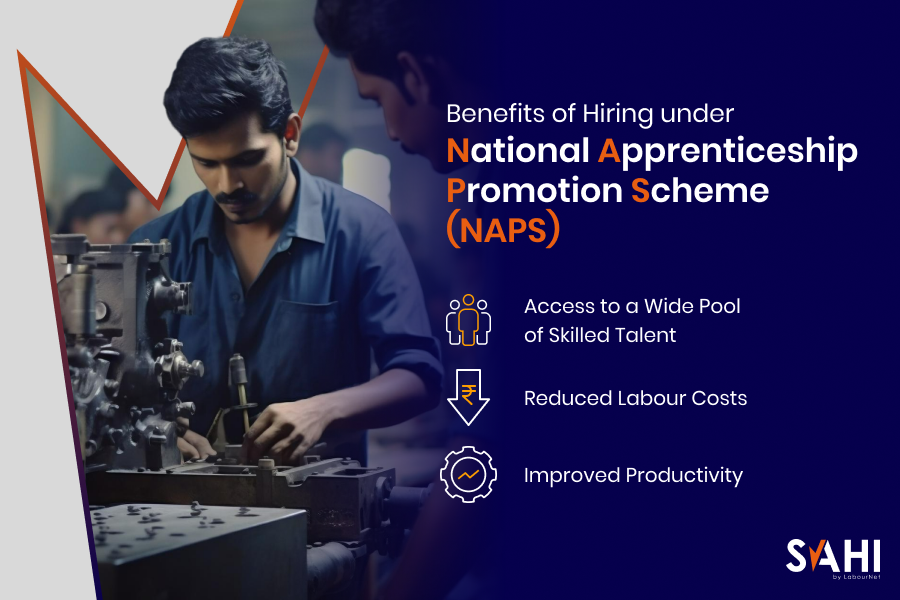In recent years, the landscape of workforce development and talent acquisition in India has seen a marked rise in apprenticeship programs.
For organisations keen on sculpting a highly skilled and adaptive workforce, especially within the blue-collar and grey-collar sectors, the apprenticeship in India model emerges as a game-changer.
But what’s driving this momentum? This is where the National Apprenticeship Promotion Scheme (NAPS) comes in. However, NAPS isn’t just another policy initiative; it’s a strategic blueprint devised to uplift the quality of apprenticeship training and bridge the skill divide.
This scheme offers them an opportunity for industries to leap ahead, while dealing with rapid technological changes and evolving skill needs. Moreover, it encourages organisations to hire apprentices, empowering them with both theory and practical knowledge.
For organisations, targeting the intricate dynamics of blue and grey-collar sectors, understanding and leveraging the National Apprenticeship Promotion Scheme can open doors to enhanced productivity.
Furthermore, it can reduce skill gaps to develop a more resilient operational framework.
This guide is designed to elucidate the intricacies of the scheme and showcase its potential in revolutionising workforce strategies.
What is the blue-collar workforce management (WFM) solution?
A blue-collar workforce management (WFM) solution refers to a suite of tools and strategies designed to optimise the productivity, efficiency, and overall management of blue-collar workers. But these workers, typically involved in manual labour or skilled trades, often require specialised training, schedules, and safety protocols.
That’s why a dedicated WFM solution for this demographic ensures their unique needs are met, from recruitment and onboarding to training, scheduling, and compliance. Such solutions not only facilitate the smooth functioning of operations but also help in reducing overhead costs.
Furthermore, they minimise errors, ensuring the well-being and satisfaction of the workforce.
In the evolving industrial landscape, where the demand for skilled blue-collar workers is on the rise, leveraging a robust WFM solution becomes imperative for businesses. This will help them to stay competitive and achieve their operational objectives.
The Importance of Apprenticeship in Today’s World
The modern business landscape demands not just knowledge but the application of that knowledge in real-world scenarios. That’s why apprenticeships have risen in prominence as a powerful tool to meet these evolving demands, especially in the context of the dynamic Indian market.
Let’s delve into why apprenticeship in India is so pivotal in today’s world.
Skill Development and Hands-on Experience
The National Apprenticeship Training Scheme has been pivotal in this shift, emphasising the importance of apprenticeships.
This is because traditional educational frameworks often impart theoretical knowledge. However, the true essence of a profession can only be grasped when this theory is applied in real-world contexts.
That’s where apprenticeship in India can bridge the skill gap.
It provides aspirants with a unique blend of classroom-based learning and hands-on work experience. As a result, the dual approach equipped them with both foundational knowledge and practical skills to ensure apprentices are job-ready.
Reducing Skill Gaps in Various Industries
Several industries today face the challenge of a widening skill gap. Hence, with technological advancements and industry requirements evolving at a rapid pace, there’s a dire need for a workforce that can adapt and learn swiftly.
The Skill India Apprentice initiative, in conjunction with the Apprenticeship Mela PMNAM, has paved the way for organisations to tap into the potential of apprenticeships.
Apprenticeships, especially under frameworks like the National Apprenticeship Promotion Scheme, are tailor-made to address this issue. Thus trainees are aligned with current industry standards, making them immediate assets to companies.
Fostering Innovation and Fresh Perspectives
Innovation is the lifeblood of any thriving industry. So, apprentices bring novel ideas to the table with their fresh perspectives and eagerness to learn and implement.
Their unique viewpoints, combined with the structured training they receive, enable them to challenge the status quo and introduce innovative solutions. Thus, they can drive businesses forward in this competitive age.
What is NAPS? A Closer Look
As the conversation around the significance of apprenticeship in India gains traction, at its centre lies a transformative initiative: The National Apprenticeship Promotion Scheme (NAPS).
But what exactly is NAPS, and why has it become so instrumental in the discourse of workforce development?
History and Evolution of NAPS
The National Apprenticeship Promotion Scheme (NAPS) is central to the effectiveness of these apprenticeship programs.
It was initiated by the Indian government and established as a response to the burgeoning need for skill development to fortify the apprenticeship ecosystem in the country.
So, recognizing the potential apprenticeships held for economic growth, the scheme increases the number of apprenticeship opportunities. Therefore, it ensures more individuals could benefit from hands-on training, practical exposure, and the mentorship offered in apprenticeship models.
Core Objectives of NAPS
Apprenticeship training is a crucial part of the National Apprenticeship Training Scheme and the larger Skill India movement.
Plus, the modern business landscape demands apprenticeship programs that ensure practical, hands-on experience. The goal is to increase involvement of industries and employers, ensuring they play an active role in the creation and execution of apprenticeship programs.
Another primary objective is to increase employability of apprentices by granting them exposure to real-world industrial scenarios, thereby enhancing their skill sets.
Benefits for Employers and Apprentices
For employers, NAPS offers access to a pool of trained, industry-ready individuals, effectively reducing the skill gap prevalent in many sectors.
Moreover, the scheme guarantees structured training and exposure to the latest industry practices, tools, and techniques for apprentices. This dual advantage ensures they’re not just employable but are also primed for long-term career growth.
The Hiring Process under NAPS
As of April 30, 2023, there were 6,75,466 active vacancies and 18,78,575 apprentices enrolled in the program from FY 2018-19 till FY 2022-23. Moreover, there are 39,213 active establishments and 648+ courses available for apprenticeship training.
Incorporating apprenticeship in India, especially under a robust structure like the National Apprenticeship Promotion Scheme (NAPS), can be a game-changer for both businesses and aspiring apprentices.
Best of all is that the process is meticulously designed to ensure transparency, compliance, and mutual benefit. Here’s an in-depth breakdown:
Key Criteria for Eligibility
For Employers:
- Must have the required infrastructure to provide practical training.
- Must adhere to all the NAPS regulations and standards.
- Employers should have a clear plan or program for the apprenticeship.
For Apprentices:
- Based on the specific apprenticeship program – age, educational qualifications, and physical fitness often vary.
- Must comply with all the rules and regulations of the apprenticeship program they’re enrolling in.
Steps to Onboard Apprentices under NAPS
Registration on the NAPS Portal
To kickstart the hiring process, employers need to register on the NAPS portal. This online portal serves as the primary platform where employers can post their apprenticeship opportunities, allowing aspiring apprentices to search for suitable roles.
Defining the Roles and Responsibilities of the Apprentice
A clear definition of roles ensures the apprentice is aware of their tasks and responsibilities. This helps in aligning expectations and paves the way for a fruitful apprenticeship experience.
Selection and Interview Process
Once applications pour in, employers can screen candidates based on their preferences. Plus, there is an interview process, designed as per the employer’s requirements.
Some may opt for a multi-stage process, while others might prefer a single round of detailed interviews.
Onboarding and Compliance
Post selection, the onboarding process begins. Here, apprentices are familiarised with the work environment, team members, and the intricacies of their role.
Most importantly, It’s crucial for employers to ensure that all the norms set by NAPS are followed during this phase. Compliance with NAPS standards ensures the apprenticeship is recognized, beneficial, and mutually rewarding.
Maximising the Potential of Apprentices
For an organisation to reap the full benefits of an apprenticeship in India, it’s imperative to cultivate an environment conducive to learning and growth. The National Apprenticeship Promotion Scheme (NAPS) emphasises this holistic development of apprentices.
The Skill India Apprentice initiative and Apprenticeship Mela PMNAM events have been instrumental in popularising apprenticeships.
Here’s how organisations can maximise the potential of their apprentices:
Structured Training Programs
Apprenticeship training, especially under frameworks like the National Apprenticeship Promotion Scheme, is tailor-made to address industry challenges.
Every apprentice comes with unique skills and learning curves. Therefore, the structured training program ensures that the apprentice grasps the essential skills methodically.
Furthermore, it sets a clear path, starting from basics and gradually delving into more complex tasks. This step-by-step approach not only makes learning more manageable but also ensures essential skills aren’t overlooked.
Mentorship and Guidance
Incorporating apprenticeship in India, especially under the National Apprenticeship Training Scheme, can lead to significant benefits. One such advantage is getting a mentor.
The importance of a mentor cannot be overstated. Having someone experienced to guide, answer queries, and provide insights is invaluable.
Hence, a mentor helps in bridging the gap between theoretical knowledge and its practical application, ensuring the apprentice understands the industry’s nuances.
Regular Assessment and Feedback
Continuous growth requires consistent reflection, so regular assessments help in identifying areas of improvement. Feedback, when given constructively, provides apprentices with a clear direction on what they’re doing right and where they need to focus more.
As a result, this iterative process of learning, implementing, and getting feedback accelerates their development.
Ensuring Real-world Exposure and Challenges
The National Apprenticeship Promotion Scheme NAPS facilitates apprenticeship training, ensuring a blend of theory and practical exposure.
Most importantly, real-world challenges carve the statue. Organisations test their skills and prepare them for the dynamic industry environment by entrusting apprentices with real tasks, allowing them to navigate through actual challenges.
This hands-on experience prepares them for the future.

Benefits of Hiring under NAPS
The National Apprenticeship Promotion Scheme (NAPS) is more than just an apprenticeship program; it’s a transformative strategy.
Most importantly, the National Apprenticeship Promotion Scheme (NAPS) in India stands as a testament to the government’s commitment to bolstering skill development and creating a workforce ready for the future.
Organisations, focusing on blue-collar and grey-collar segments, stand to gain substantially from this scheme. Here are the key advantages:
Access to a Wide Pool of Skilled Talent
The Skill India Apprentice program, in conjunction with the Apprenticeship Mela PMNAM, is changing the face of workforce development in India.
NAPS facilitates a bridge between eager learners and industries in need. Through the program, companies can tap into a reservoir of talent—individuals who are trained, ready, and enthusiastic.
This greatly eases the talent acquisition process, ensuring a constant flow of skilled workforce ready to contribute.
Reduced Labour Costs
Apprentices reduce labour costs by offering businesses a workforce trained at a lower rate.
They combine learning with on-the-job training, enabling employers to shape their skills according to company needs. Employers may also receive financial incentives for hiring apprentices, further offsetting costs.
Over time, apprentices increase productivity without the immediate expense of skilled labour rates.
Improved Productivity
Apprentices enhance productivity by bringing fresh perspectives, enthusiasm, and updated training into the workplace.
As they learn and adapt to company-specific procedures, they fill skills gaps and reduce the workload on experienced staff. The hands-on training model ensures that apprentices contribute while learning, optimising workforce efficiency and effectiveness.
Enhancing Company Reputation and Brand Image
Being part of a national initiative such as NAPS not only brings tangible benefits but also elevates a company’s standing in the public eye.
Furthermore, it showcases the firm’s commitment to skill development, corporate social responsibility, and nation-building—factors that can significantly enhance its brand image.
Examples of How Companies Might Benefit from NAPS
The impact of the National Apprenticeship Promotion Scheme (NAPS) is more than just numbers and policies. It’s about the transformative stories of organisations and individuals.
Let’s dive into a few real-life narratives that illustrate the profound impact of NAPS.
Journey with NAPS
Through the National Apprenticeship Training Scheme and Apprenticeship Mela PMNAM, India is making significant strides in workforce development.
Suppose a company, a rising player in the manufacturing sector, first learned of NAPS, as they were struggling with a shortage of skilled labour. After enrolling in the scheme, they gain access to a vast pool of dedicated apprentices.
Moreover, these apprentices are backed by structured training and quickly become assets to the company. Hence, such a company would attribute a significant portion of its operational efficiency and productivity boost to the apprentices they onboarded through NAPS.
How A Company can transform its workforce through apprentices
Let’s assume a company, a service-oriented enterprise, is grappling with high attrition rates and inconsistent service quality. Their engagement with NAPS proves a game-changer.
Through the apprenticeship training under the scheme, they can build a skilled and loyal team. Apprentices seamlessly integrate into the company’s culture and ethos, thanks to the program’s mentorship and real-world exposure.
The result? A marked improvement in service consistency, customer satisfaction, and a noticeable reduction in employee turnover.
The growth story of an individual under the NAPS scheme
Another example could be a young and enthusiastic individual from a small town in India, who had the drive but lacked direction. Through NAPS, she found an opportunity with a leading tech firm. Her journey from a novice to a valued team leader in just a few years could be a testament to the scheme’s potency.
With structured guidance, regular feedback, and hands-on challenges, she can hone her technical skills, while developing critical soft skills. Ultimately, she might stand as an embodiment of the potential that NAPS holds for individuals eager to carve a niche for themselves.
Conclusion
The apprenticeship in India, particularly through the National Apprenticeship Promotion Scheme (NAPS), stands as a beacon for skill development and workforce empowerment.
It’s not merely a program but a robust strategy to bridge skill gaps, enhance employability, and foster innovation in today’s fast-evolving industries. Through real-world success stories, we’ve seen how NAPS can revolutionise both organisations and individual careers, driving growth, efficiency, and adaptability.
For businesses navigating the competitive landscape, embracing the NAPS initiative through SAHI isn’t just an option—it’s a progressive step towards a brighter, skilled, and sustainable future. SAHI ensures you can invest in and leverage apprenticeships, laying the foundation for a workforce that’s ready for tomorrow’s challenges.


